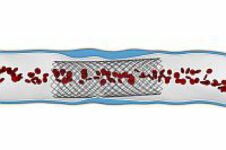Original title: Radial Versus Femoral Randomized Investigation in ST-Segment Elevation Acute Coronary síndrome. The RIFLE-STEACS (Radial Versus Femoral Randomized Investigation in ST-Elevation Acute Coronary Syndrome) Study. Reference: Enrico Romagnoli et al. J Am Coll Cardiol 2012;60:2481–9. Bleeding in patients with acute coronary syndromes (ACS) is an independent predictor of morbidity and mortality. Until today, evidence supporting the radial…
Strategies for treating left coronary trunk restenosis.
Original title: Clinical and Procedural Predictors of Suboptimal Outcome After the Treatment of Drug-Eluting Stent Restenosis in the Unprotected Distal Left Main Stem The Milan and New-Tokyo (MITO) Registry. Reference: Circ Cardiovasc Interv. 2012;5: 491-498 We have very little data on the percutaneous treatment of restenosis of an unprotected LMCA. The aim of this study was to evaluate…
Future strategies to prevent restenosis and stent thrombosis
Original title: Endothelial cell repopulation after stenting determines in-stent neointima formation: effects of bare-metal vs. drug-eluting stents and genetic endothelial cell modification. Reference: Douglas G et al. European Heart Journal doi:10.1093/eurheartj/ehs240 Experimental models of vascular injury have shown that the rate of endothelial cell repopulation post-injury is a critical factor in determining subsequent neointima formation as well as…
Complex angioplasty with ventricular assist
Original title: Real-Word of the Impella 2.5 Circulatory Support System in Complex High-Risk Percutaneous Coronary Intervention: The USpella Registry Reference: Brijeshwar maini, et al. Catheterization and Cardiovscular Intervention For about a decade angioplasty has begun to be performed in increasingly complex patients (PE) such as those with left coronary trunk injury, 3-vessel injury, poor ventricular function and surgically…
High-dose atorvastatin for prevention of contrast nephropathy
Original title: Impact of a High Loading Dose of Atorvastatin on Contrast-Induced Acute Kidney Injury. Reference: Quintavalle et al. CIRCULATIONAHA.112.10331, 2012 Patients included in this study represent a subgroup with chronic renal failure (CRF) enrolled in the NAPLES II trial who were randomized to atorvastatin 80 mg 24 hours before angioplasty, (n = 202) versus the control group…
Risk score of thrombosis in patients with acute coronary syndrome
Original title: Development and Validation of a Stent Thrombosis Risk Score in Patients With Acute Coronary Syndromes. Reference: George D. Dangas et al. J Am Coll Cardiol Intv 2012;5:1097–105. The implantation of a stent in a pro thrombotic condition such as acute coronary syndrome (ACS) is associated with a higher incidence of stent thrombosis. There is no data…
Is a counter-pulsation balloon useful in myocardial infarction?
Original title: Intraaortic Balloon Support for Myocardial Infarction with Cardiogenic Shock (for the IABP-Shock II Trial Investigator) Reference: Holger T, et al. NEJM 367;14:1287 The rate of mortality in cardiogenic shock secondary to acute myocardial infarction (AMI) is high even in patients receiving early revascularization. The use of an intra-aortic balloon counter-pulsation pump (IABP) according to the…
Risk scores in patients with acute coronary syndromes
Original title: Walking Beyond the GRACE (Global Registry of Acute Coronary Events) Model in the Death Risk Stratification During Hospitalization in Patients With Acute Coronary Syndrome. Reference: Rapouseiras-Roubín S, et al. J Am Coll Cardiol Intv 2012;5:1117–25. Discriminatory power of risk score predictors become fundamental in the management of patients with acute coronary syndromes. This tool lets you…
Again in the bifurcation, less is more.
It has been reported that the two stents technique is not superior to a provisional stent when treating bifurcations. However, the optimal approach to rescue a secondary branch (SB) when initially opting for provisional stenting has not been established. The aim of this study was to determine angioplasty indication using balloon or stent for…
Stent MGuard, primary angioplasty with a higher TIMI III
Original title: The MASTER Trial – Prospective, Randomized, Multicenter Evaluation of a Polyethylene Terephthalate Micronet Mesh–Covered Stent (MGuard) in ST-Segment Elevation Myocardial Infarction. Reference: Gregg W. Stone et. al. J Am Coll Cardiol 2012; 60: 1975-1984 Primary angioplasty has proven effective in restoring epicardial flow but myocardial perfusion is often suboptimal. One of the main mechanisms is distal…
The use of a paclitaxel eluting balloon in small vessels
Original title: A Randomized Multicenter Study Comparing a Paclitaxel Drug-Eluting Balloon With a Paclitaxel-Eluting Stent in Small Coronary Vessels. The BELLO (Balloon Elution and Late Loss Optimization) Study Reference: Referencia: Azeem Latib et al J Am Coll Cardiol 2012;()doi:10.1016/j.jacc.2012.09.020 The utility of paclitaxel-eluting balloons to treat in-stent restenosis is known but data for novo lesions is more limited. …




